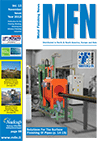E-Archive
Shot Peening in the Automotive Industry
in Vol. 13 - November Issue - Year 2012
Shot Peening And Fatigue Strength Assessment

Mario Guagliano
I think that all the readers of this magazine know that shot peening is a mechanical treatment that contributes greatly to the improvement of fatigue life and strength. Many research studies were developed and many papers were written to assess the real increase of the fatigue strength induced by shot peening with respect to untreated parts. And it is possible to affirm that the effect can be quite high, even if strongly dependent on the considered application and on the parameters used to perform the treatment. Shot size and material, shot velocity, and coverage are all parameters that strongly affect the final result of shot peening and should be chosen by considering the part to be treated, its geometry and material, the stress state and gradient in the critical points, and so on.
It is not easy and indeed, the papers and reports that it is possible to find in the journals and in the conference proceedings do not solve the problem and do not clearly indicate the quantitative benefit that can be obtained by properly shot peening a metal part.
And if you hope to find better suggestions about durability of shot-peened parts in international standards, you will remain disappointed; most of the codes do not consider shot peening at all from a quantitative point of view. To my best knowledge, only the AGMA standard on gears underlines that, by using shot peening, you can improve the fatigue limit of gears up to 25%. But we know that this is a very conservative value and you can expect much more.
There are two reasons why the importance of shot peening is underestimated by design codes. The first one is that the effective results of the shot peening process are strongly related to the parameters used, since they affect the residual stress state, the surface roughness and the surface work hardening; the main factors that affect the fatigue strength. And the parameters should be chosen considering also the part to be treated and its in-service working conditions.
The second reason is related to the necessity to define a quantitative criterion to assess the fatigue strength of the peened parts, once the residual stresses, the roughness and the surface layer material characteristics are known.
This is still a critical point, since a well-established quantitative criterion able to consider the modification induced by shot peening in the surface layer has not yet been defined. It is true that in scientific and technical papers, you can find many attempts and many formulas developed with this aim, and it is also true that they work very well with the particular case considered in the paper itself. But if you apply the same criterion to other cases, it is hard to find good correspondence with the experimental results.
So the question is: how can a criterion be chosen for the fatigue assessment of a shot-peened part? There are two main groups of criteria that can be used. The first is based on the calculation of the local stresses in the critical zones of a mechanical element considering the residual stresses due to shot peening as a mean stress to be added to the applied one. The surface work hardening is considered with some empirical formula (that was developed in particular cases) and is considered to increase the local fatigue limit. This is the critical point of these methods, since the element to be investigated has to be of the same material with similar thermal treatment before shot peening to give reliable results.
The second group is based on fracture mechanics concepts, that is to say, the ability of shot peening to stop crack propagation is considered. This approach is generally used when sharp-notched parts are considered or when you have to consider some small defect in the material acting as a crack initiation point.
Also in this case, the problem is the ability of these criteria to consider the local modification induced by shot peening.
What can we do? There is no unique answer and the best way to proceed cannot ignore some experimental tests. Anyway, at least if I consider my experience, the correct application of the FKM standard (that considers both a nominal stress and a local stress approach) is generally a good choice.
Shot Peening in the Automotive Industry
by Mario Guagliano
Contributing Editor MFN and
Associate Professor of Technical University of Milan
20156 Milan, Italy
E-mail: mario@mfn.li
Author: Mario Guagliano




























